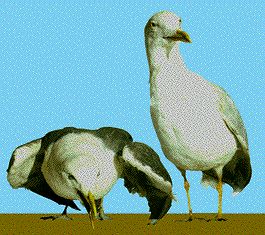The evidence for evolution - Why are ring species interesting?

What is a ring species?
A ring species is a situation in which two populations which do not interbreed are living in the same region and connected by a geographic ring of populations that can interbreed. Famous examples of ring species are the herring and lesser black-backed gulls in northern Europe (pictured opposite) and the Ensatina salamanders of the West Coast of the USA.
A ring species can be best imagined like this:
Imagine a species that is geographically distributed in a straight line from east to west across America: it is possible that the forms in the east and west are so different that they could not interbreed. Now imagine taking the line and bending it into a circle, such that the end points (formerly in the east and west) come to overlap in space.
If they do not interbreed then the geographic distribution of the species will be in the shape of a ring, and they will be 'ring species': the extreme forms do not interbreed in the region of overlap. A ring species has an almost continuous set of intermediates between two distinct species, and these intermediates happen to be arranged in a ring. At most points in the ring, there is only one species; but there are two where the end-points meet.
| Next |



